The PRA1 gene family in Arabidopsis
- PMID: 18583532
- PMCID: PMC2492607
- DOI: 10.1104/pp.108.122226
The PRA1 gene family in Arabidopsis
Abstract
Prenylated Rab acceptor 1 (PRA1) domain proteins are small transmembrane proteins that regulate vesicle trafficking as receptors of Rab GTPases and the vacuolar soluble N-ethylmaleimide-sensitive factor attachment receptor protein VAMP2. However, little is known about PRA1 family members in plants. Sequence analysis revealed that higher plants, compared with animals and primitive plants, possess an expanded family of PRA1 domain-containing proteins. The Arabidopsis (Arabidopsis thaliana) PRA1 (AtPRA1) proteins were found to homodimerize and heterodimerize in a manner corresponding to their phylogenetic distribution. Different AtPRA1 family members displayed distinct expression patterns, with a preference for vascular cells and expanding or developing tissues. AtPRA1 genes were significantly coexpressed with Rab GTPases and genes encoding vesicle transport proteins, suggesting an involvement in the vesicle trafficking process similar to that of their animal counterparts. Correspondingly, AtPRA1 proteins were localized in the endoplasmic reticulum, Golgi apparatus, and endosomes/prevacuolar compartments, hinting at a function in both secretory and endocytic intracellular trafficking pathways. Taken together, our data reveal a high functional diversity of AtPRA1 proteins, probably dealing with the various demands of the complex trafficking system.
Figures
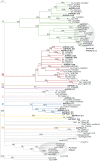


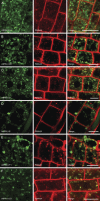
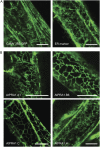

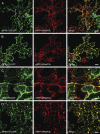
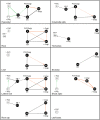
Similar articles
-
The Prenylated Rab GTPase Receptor PRA1.F4 Contributes to Protein Exit from the Golgi Apparatus.Plant Physiol. 2017 Jul;174(3):1576-1594. doi: 10.1104/pp.17.00466. Epub 2017 May 9. Plant Physiol. 2017. PMID: 28487479 Free PMC article.
-
An Arabidopsis prenylated Rab acceptor 1 isoform, AtPRA1.B6, displays differential inhibitory effects on anterograde trafficking of proteins at the endoplasmic reticulum.Plant Physiol. 2011 Oct;157(2):645-58. doi: 10.1104/pp.111.180810. Epub 2011 Aug 9. Plant Physiol. 2011. PMID: 21828250 Free PMC article.
-
Localization and trafficking of an isoform of the AtPRA1 family to the Golgi apparatus depend on both N- and C-terminal sequence motifs.Traffic. 2011 Feb;12(2):185-200. doi: 10.1111/j.1600-0854.2010.01140.x. Epub 2010 Dec 1. Traffic. 2011. PMID: 21059161
-
Helping hands for budding prospects: ENTH/ANTH/VHS accessory proteins in endocytosis, vacuolar transport, and secretion.Plant Cell. 2014 Nov;26(11):4232-44. doi: 10.1105/tpc.114.131680. Epub 2014 Nov 21. Plant Cell. 2014. PMID: 25415979 Free PMC article. Review.
-
Multiple Roles of Rab GTPases at the Golgi.Results Probl Cell Differ. 2019;67:95-123. doi: 10.1007/978-3-030-23173-6_6. Results Probl Cell Differ. 2019. PMID: 31435794 Review.
Cited by
-
Functional Characterization of a Gene in Sedum alfredii Hance Resembling Rubber Elongation Factor Endowed with Functions Associated with Cadmium Tolerance.Front Plant Sci. 2016 Jun 29;7:965. doi: 10.3389/fpls.2016.00965. eCollection 2016. Front Plant Sci. 2016. PMID: 27446189 Free PMC article.
-
Root proteomic and metabolic analyses reveal specific responses to drought stress in differently tolerant grapevine rootstocks.BMC Plant Biol. 2018 Jun 20;18(1):126. doi: 10.1186/s12870-018-1343-0. BMC Plant Biol. 2018. PMID: 29925320 Free PMC article.
-
Di-arginine and FFAT-like motifs retain a subpopulation of PRA1 at ER-mitochondria membrane contact sites.PLoS One. 2020 Dec 1;15(12):e0243075. doi: 10.1371/journal.pone.0243075. eCollection 2020. PLoS One. 2020. PMID: 33259547 Free PMC article.
-
The Prenylated Rab GTPase Receptor PRA1.F4 Contributes to Protein Exit from the Golgi Apparatus.Plant Physiol. 2017 Jul;174(3):1576-1594. doi: 10.1104/pp.17.00466. Epub 2017 May 9. Plant Physiol. 2017. PMID: 28487479 Free PMC article.
-
OsPRA1 plays a significant role in targeting of OsRab7 into the tonoplast via the prevacuolar compartment during vacuolar trafficking in plant cells.Planta. 2010 Sep;232(4):861-71. doi: 10.1007/s00425-010-1226-6. Epub 2010 Jul 15. Planta. 2010. PMID: 20632185
References
-
- Abdul-Ghani M, Gougeon P-Y, Prosser DC, Da-Silva LF, Ngsee JK (2001) PRA isoforms are targeted to distinct membrane compartments. J Biol Chem 276 6225–6233 - PubMed
-
- Akiduki S, Ochiishi T, Ikemoto MJ (2007) Neural localization of addicsin in mouse brain. Neurosci Lett 426 149–154 - PubMed
-
- Aoki K, Ogata Y, Shibata D (2007) Approaches for extracting practical information from gene co-expression networks in plant biology. Plant Cell Physiol 48 381–390 - PubMed
-
- Assaad FF (2001) Of weeds and men: what genomes teach us about plant cell biology. Curr Opin Plant Biol 4 478–487 - PubMed
-
- Bassham DC, Raikhel NV (2000) Unique features of the plant vacuolar sorting machinery. Curr Opin Cell Biol 12 491–495 - PubMed
Publication types
MeSH terms
Substances
LinkOut - more resources
Full Text Sources
Molecular Biology Databases

